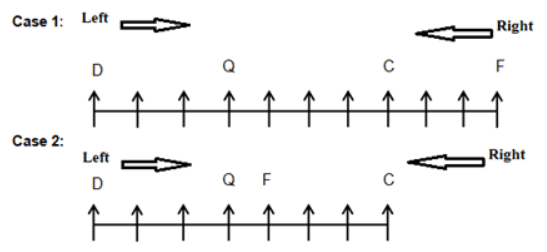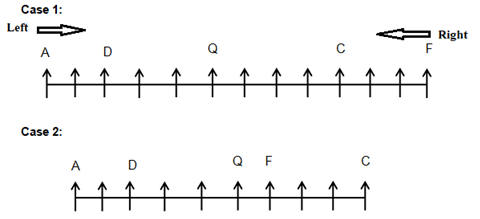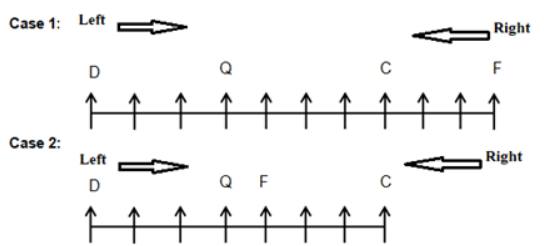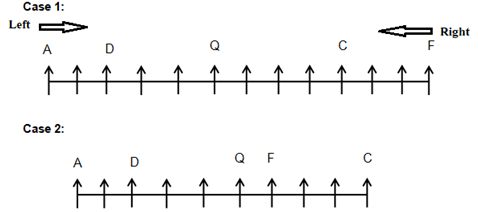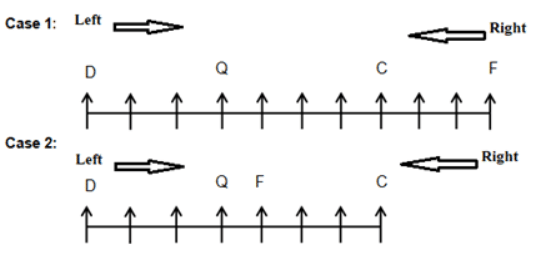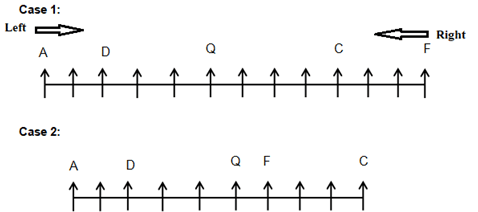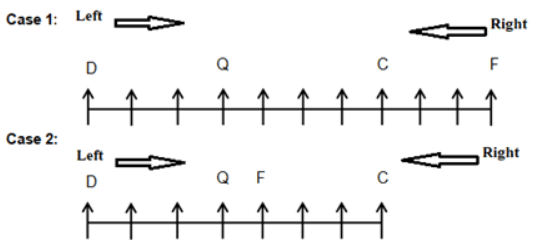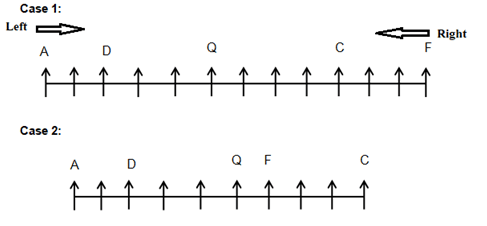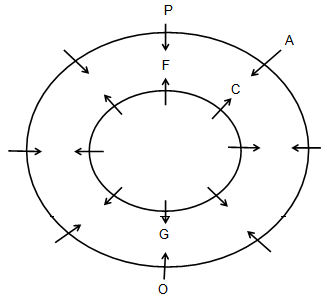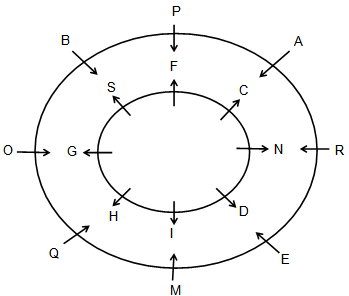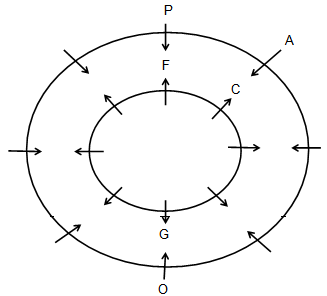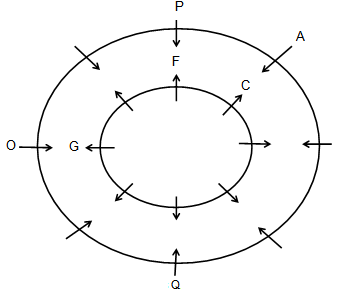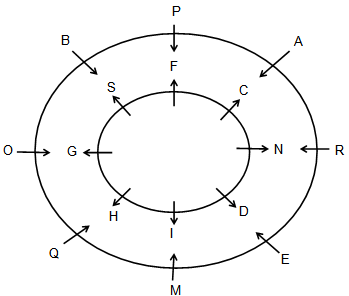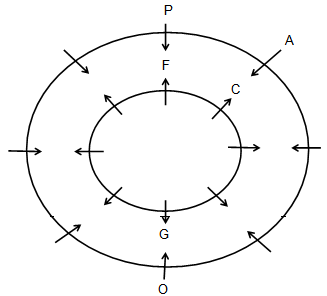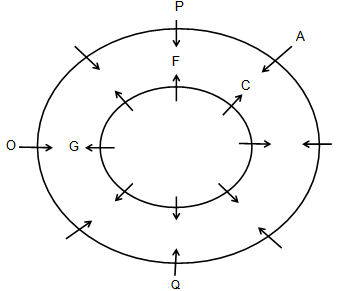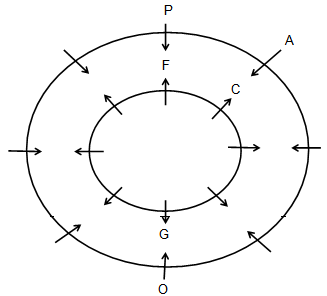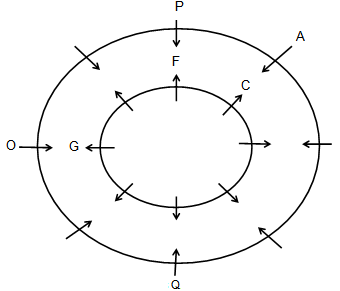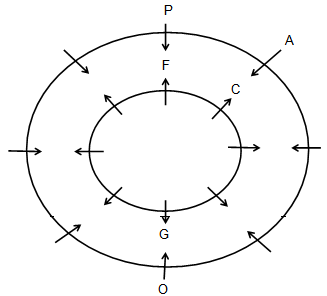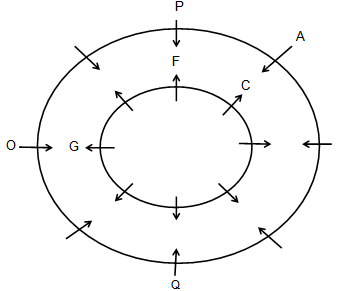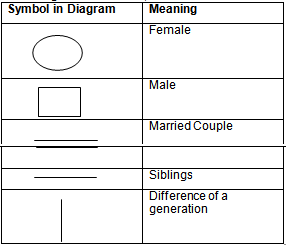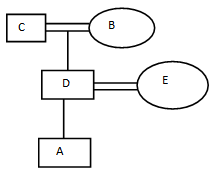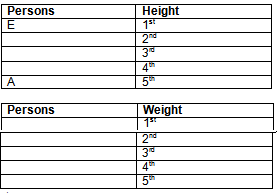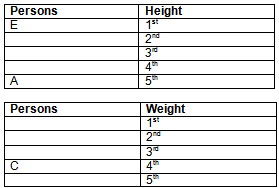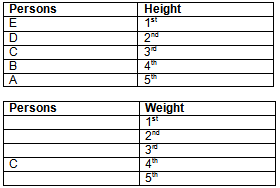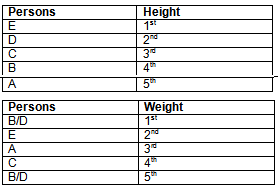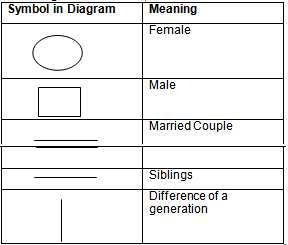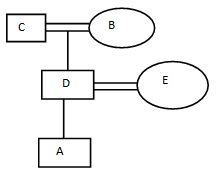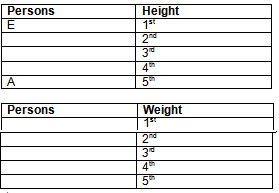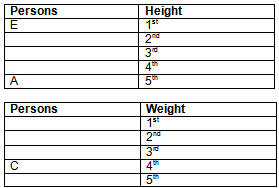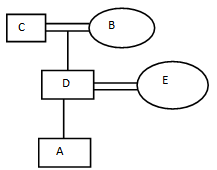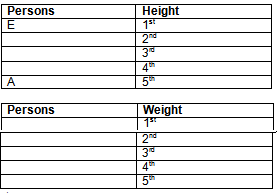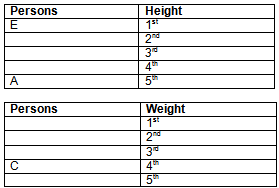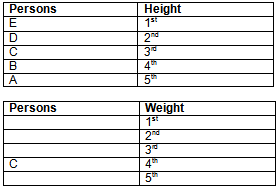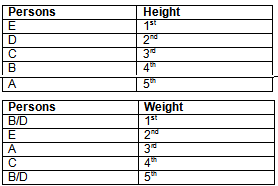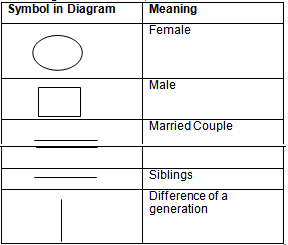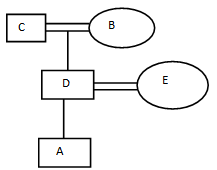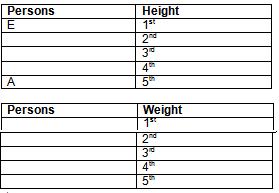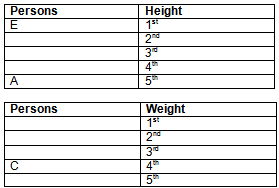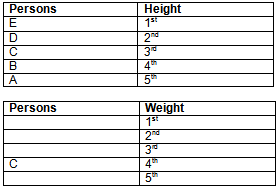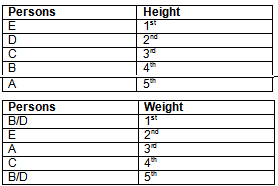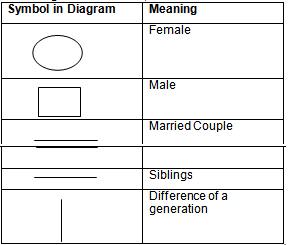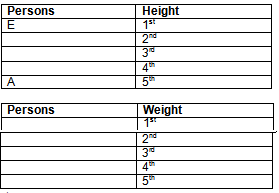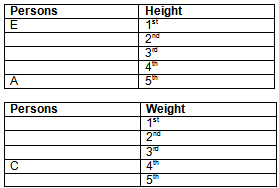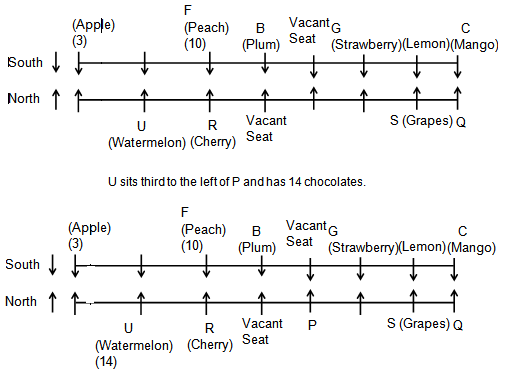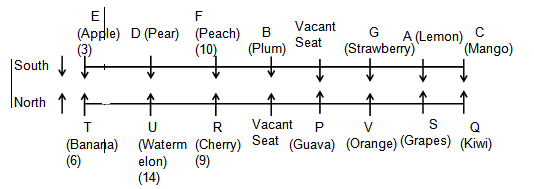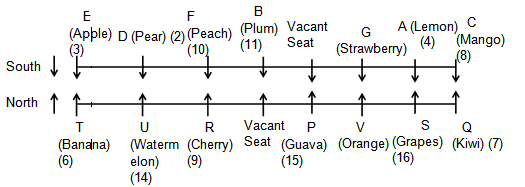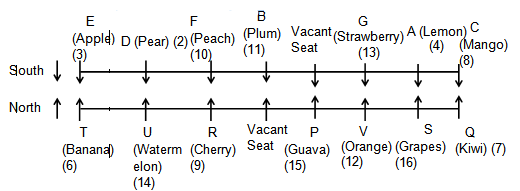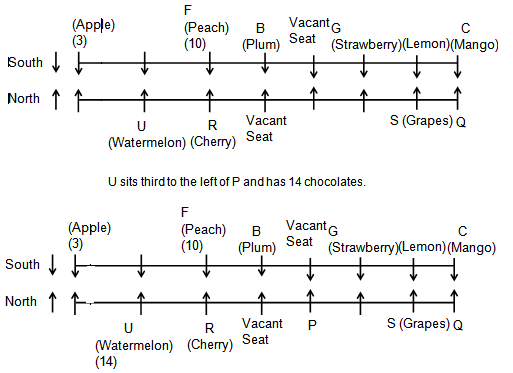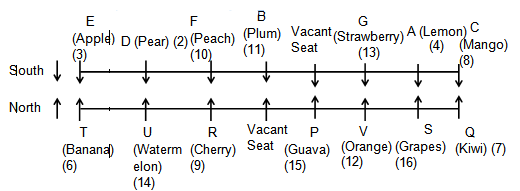IBPS PO Mains Mock Test - 4 - Bank Exams MCQ
30 Questions MCQ Test - IBPS PO Mains Mock Test - 4
Direction: Read the following information carefully and answer the question given below-
Some persons are sitting in a linear row and all of them are facing in South direction. Only three persons sit between Q and C. Only two persons sit between C and F. E is not an immediate neighbour of C. D is third to the right of Q. More than three persons sit between Q and A and A sits to the right of Q. There is no immediate neighbour of A and C. Less than five persons sit between G and D and A sits to the left of G. Less than two persons sits between D and A. Less than two persons sit between E and the person who sits on left extreme end and no less than 13 persons sits between G and E. More than 3 persons sit between G and D. F sits immediate left of E.
Who among the following are immediate neighbours of each other?
Direction: Read the following information carefully and answer the question given below-
Some persons are sitting in a linear row and all of them are facing in South direction. Only three persons sit between Q and C. Only two persons sit between C and F. E is not an immediate neighbour of C. D is third to the right of Q. More than three persons sit between Q and A and A sits to the right of Q. There is no immediate neighbour of A and C. Less than five persons sit between G and D and A sits to the left of G. Less than two persons sits between D and A. Less than two persons sit between E and the person who sits on left extreme end and no less than 13 persons sits between G and E. More than 3 persons sit between G and D. F sits immediate left of E.
If B sits second to the right of C, then how many persons sit between B and A?
Direction: Read the following information carefully and answer the question given below-
Some persons are sitting in a linear row and all of them are facing in South direction. Only three persons sit between Q and C. Only two persons sit between C and F. E is not an immediate neighbour of C. D is third to the right of Q. More than three persons sit between Q and A and A sits to the right of Q. There is no immediate neighbour of A and C. Less than five persons sit between G and D and A sits to the left of G. Less than two persons sits between D and A. Less than two persons sit between E and the person who sits on left extreme end and no less than 13 persons sits between G and E. More than 3 persons sit between G and D. F sits immediate left of E.
Who among the following sits on the extreme left end ?
Direction: Read the following information carefully and answer the question given below-
Some persons are sitting in a linear row and all of them are facing in South direction. Only three persons sit between Q and C. Only two persons sit between C and F. E is not an immediate neighbour of C. D is third to the right of Q. More than three persons sit between Q and A and A sits to the right of Q. There is no immediate neighbour of A and C. Less than five persons sit between G and D and A sits to the left of G. Less than two persons sits between D and A. Less than two persons sit between E and the person who sits on left extreme end and no less than 13 persons sits between G and E. More than 3 persons sit between G and D. F sits immediate left of E.
Which of the following is not correct?
Correct Answer
Direction: Read the following information carefully and answer the question given below-
Some persons are sitting in a linear row and all of them are facing in South direction. Only three persons sit between Q and C. Only two persons sit between C and F. E is not an immediate neighbour of C. D is third to the right of Q. More than three persons sit between Q and A and A sits to the right of Q. There is no immediate neighbour of A and C. Less than five persons sit between G and D and A sits to the left of G. Less than two persons sits between D and A. Less than two persons sit between E and the person who sits on left extreme end and no less than 13 persons sits between G and E. More than 3 persons sit between G and D. F sits immediate left of E.
How many persons are present between D and E?
Direction : In the following problems, there is one question and some statements given below the question. You have to decide whether the data given in the statements is sufficient to answer the question. Read all the statements carefully and find out which of the statements is/are sufficient to answer the given question. Choose the correct alternative for each question.
Seven persons A, B, C, D, E, F and G measured their heights. How many persons are shorter than D?
I. A is taller than both B and C but not the tallest. F is shorter than G.
II. B is taller than both G and F. D is taller than C.
III. C is taller than G. E is taller than both C and D who is shorter than B.
Direction: Read the following information carefully and answer the question given below-
Sixteen persons A, B, C, D, E, F, G, H, M, N, O, P, Q, R, S and I are sitting around two circular tables. There is small circular table inside the bigger circular table. The persons sitting around the inner circular table faces outside and the persons sitting around the outer circular table faces inside in such a way persons sitting on both tables facing each other.
C sits to the immediate right of F. Only two persons are sitting between C and G who faces O. G and O sit on different tables. Two persons sit between B and M. Four persons are sitting between D and F. H sits to the immediate left of G and faces Q. F who faces P faces outside. A faces C. The one who faces E sits exactly between N and I who faces M. Three persons are sitting between O and R who sits exactly between A and E.
Who among the following faces S?
Direction: Read the following information carefully and answer the question given below-
Sixteen persons A, B, C, D, E, F, G, H, M, N, O, P, Q, R, S and I are sitting around two circular tables. There is small circular table inside the bigger circular table. The persons sitting around the inner circular table faces outside and the persons sitting around the outer circular table faces inside in such a way persons sitting on both tables facing each other.
C sits to the immediate right of F. Only two persons are sitting between C and G who faces O. G and O sit on different tables. Two persons sit between B and M. Four persons are sitting between D and F. H sits to the immediate left of G and faces Q. F who faces P faces outside. A faces C. The one who faces E sits exactly between N and I who faces M. Three persons are sitting between O and R who sits exactly between A and E.
Who among the following sits exactly between P and M?
Direction: Read the following information carefully and answer the question given below-
Sixteen persons A, B, C, D, E, F, G, H, M, N, O, P, Q, R, S and I are sitting around two circular tables. There is small circular table inside the bigger circular table. The persons sitting around the inner circular table faces outside and the persons sitting around the outer circular table faces inside in such a way persons sitting on both tables facing each other.
C sits to the immediate right of F. Only two persons are sitting between C and G who faces O. G and O sit on different tables. Two persons sit between B and M. Four persons are sitting between D and F. H sits to the immediate left of G and faces Q. F who faces P faces outside. A faces C. The one who faces E sits exactly between N and I who faces M. Three persons are sitting between O and R who sits exactly between A and E.
Four of the following are alike in a certain way and form a group. Which of the following does not belong to that group ?
Direction: Read the following information carefully and answer the question given below-
Sixteen persons A, B, C, D, E, F, G, H, M, N, O, P, Q, R, S and I are sitting around two circular tables. There is small circular table inside the bigger circular table. The persons sitting around the inner circular table faces outside and the persons sitting around the outer circular table faces inside in such a way persons sitting on both tables facing each other.
C sits to the immediate right of F. Only two persons are sitting between C and G who faces O. G and O sit on different tables. Two persons sit between B and M. Four persons are sitting between D and F. H sits to the immediate left of G and faces Q. F who faces P faces outside. A faces C. The one who faces E sits exactly between N and I who faces M. Three persons are sitting between O and R who sits exactly between A and E.
Who among the following sits third to the right of N?
Direction: Read the following information carefully and answer the question given below-
Sixteen persons A, B, C, D, E, F, G, H, M, N, O, P, Q, R, S and I are sitting around two circular tables. There is small circular table inside the bigger circular table. The persons sitting around the inner circular table faces outside and the persons sitting around the outer circular table faces inside in such a way persons sitting on both tables facing each other.
C sits to the immediate right of F. Only two persons are sitting between C and G who faces O. G and O sit on different tables. Two persons sit between B and M. Four persons are sitting between D and F. H sits to the immediate left of G and faces Q. F who faces P faces outside. A faces C. The one who faces E sits exactly between N and I who faces M. Three persons are sitting between O and R who sits exactly between A and E.
Who among the following is the immediate neighbor of Q?
Direction: In the following problems, there is one question and some statements given below the question. You have to decide whether the data given in the statements is sufficient to answer the question. Read all the statements carefully and find out which of the statements is/are sufficient to answer the given question. Choose the correct alternative for each question.
How many persons are sitting in the row?
I. Neha is 14th from the left end. Four persons are sitting between Neha and Anshika. Neha is to the left of Anshika.
II. Shruti is 14th from the right end. Two persons are sitting between Nikita and Shruti who is sitting to the right of Nikita.
III. No. of persons sitting between Anshika and Ankita is equal to that sitting between Ankita and Nikita.
Direction: In the following problems, there is one question and some statements given below the question. You have to decide whether the data given in the statements is sufficient to answer the question. Read all the statements carefully and find out which of the statements is/are sufficient to answer the given question. Choose the correct alternative for each question.
Seven persons P, Q, R, S, T, U and V are sitting in a straight line facing north. What is the position of P with respect to Q?
I. Two persons sit between P and Q. R sits to the immediate left of Q.
II. One person sits between S and U. Q is to the immediate left of S.
III. T is to the immediate right of P. V sits fourth to the right of T.
Direction: Read the following information carefully and answer the question given below-
A, B, C, D and E are five members of a family and each of them has different age viz. 67, 60, 35, 30 and 15 but not necessarily in the same order. B is the mother of D, who is the husband of E. E is the daughter-in-law of C and has no siblings. A is the son of E. The age of one of the grandparent is a prime number. The age of B is twice the age of her daughter – in – law. The difference of age of father and son is divisible by 5. Each of the five persons has different height and weight. If they were given ranks 1 to 5 according to their heights (in decreasing order of heights) and weights (in decreasing order of weights), no person got the same rank in both the categories.
For any person, the number of persons heavier than him is not equal to the number of persons shorter than him. E, the tallest person is heavier than A, the shortest person. C is heavier than only one person and is shorter than D.
Each person lives in different cities among – Delhi, Mumbai, Bangalore, Chennai and Hyderabad and work in different companies among – P, Q, R, S and T, not necessarily in the same order.
A lives in Delhi but does not work in company Q. C works in company T. The person who lives in Bangalore works in company S. Neither D nor B lives in Chennai. B works in company P and E lives in Hyderabad.
Who among the following is third heaviest?
Direction: Read the following information carefully and answer the question given below-
A, B, C, D and E are five members of a family and each of them has different age viz. 67, 60, 35, 30 and 15 but not necessarily in the same order. B is the mother of D, who is the husband of E. E is the daughter-in-law of C and has no siblings. A is the son of E. The age of one of the grandparent is a prime number. The age of B is twice the age of her daughter – in – law. The difference of age of father and son is divisible by 5. Each of the five persons has different height and weight. If they were given ranks 1 to 5 according to their heights (in decreasing order of heights) and weights (in decreasing order of weights), no person got the same rank in both the categories.
For any person, the number of persons heavier than him is not equal to the number of persons shorter than him. E, the tallest person is heavier than A, the shortest person. C is heavier than only one person and is shorter than D.
Each person lives in different cities among – Delhi, Mumbai, Bangalore, Chennai and Hyderabad and work in different companies among – P, Q, R, S and T, not necessarily in the same order.
A lives in Delhi but does not work in company Q. C works in company T. The person who lives in Bangalore works in company S. Neither D nor B lives in Chennai. B works in company P and E lives in Hyderabad.
How is A related to B?
Direction: Read the following information carefully and answer the question given below-
A, B, C, D and E are five members of a family and each of them has different age viz. 67, 60, 35, 30 and 15 but not necessarily in the same order. B is the mother of D, who is the husband of E. E is the daughter-in-law of C and has no siblings. A is the son of E. The age of one of the grandparent is a prime number. The age of B is twice the age of her daughter – in – law. The difference of age of father and son is divisible by 5. Each of the five persons has different height and weight. If they were given ranks 1 to 5 according to their heights (in decreasing order of heights) and weights (in decreasing order of weights), no person got the same rank in both the categories.
For any person, the number of persons heavier than him is not equal to the number of persons shorter than him. E, the tallest person is heavier than A, the shortest person. C is heavier than only one person and is shorter than D.
Each person lives in different cities among – Delhi, Mumbai, Bangalore, Chennai and Hyderabad and work in different companies among – P, Q, R, S and T, not necessarily in the same order.
A lives in Delhi but does not work in company Q. C works in company T. The person who lives in Bangalore works in company S. Neither D nor B lives in Chennai. B works in company P and E lives in Hyderabad.
In which city does the person who works in company P lives?
Direction: Read the following information carefully and answer the question given below-
A, B, C, D and E are five members of a family and each of them has different age viz. 67, 60, 35, 30 and 15 but not necessarily in the same order. B is the mother of D, who is the husband of E. E is the daughter-in-law of C and has no siblings. A is the son of E. The age of one of the grandparent is a prime number. The age of B is twice the age of her daughter – in – law. The difference of age of father and son is divisible by 5. Each of the five persons has different height and weight. If they were given ranks 1 to 5 according to their heights (in decreasing order of heights) and weights (in decreasing order of weights), no person got the same rank in both the categories.
For any person, the number of persons heavier than him is not equal to the number of persons shorter than him. E, the tallest person is heavier than A, the shortest person. C is heavier than only one person and is shorter than D.
Each person lives in different cities among – Delhi, Mumbai, Bangalore, Chennai and Hyderabad and work in different companies among – P, Q, R, S and T, not necessarily in the same order.
A lives in Delhi but does not work in company Q. C works in company T. The person who lives in Bangalore works in company S. Neither D nor B lives in Chennai. B works in company P and E lives in Hyderabad.
What is the sum of ranks of C in both the categories?
Direction: Read the following information carefully and answer the question given below-
A, B, C, D and E are five members of a family and each of them has different age viz. 67, 60, 35, 30 and 15 but not necessarily in the same order. B is the mother of D, who is the husband of E. E is the daughter-in-law of C and has no siblings. A is the son of E. The age of one of the grandparent is a prime number. The age of B is twice the age of her daughter – in – law. The difference of age of father and son is divisible by 5. Each of the five persons has different height and weight. If they were given ranks 1 to 5 according to their heights (in decreasing order of heights) and weights (in decreasing order of weights), no person got the same rank in both the categories.
For any person, the number of persons heavier than him is not equal to the number of persons shorter than him. E, the tallest person is heavier than A, the shortest person. C is heavier than only one person and is shorter than D.
Each person lives in different cities among – Delhi, Mumbai, Bangalore, Chennai and Hyderabad and work in different companies among – P, Q, R, S and T, not necessarily in the same order.
A lives in Delhi but does not work in company Q. C works in company T. The person who lives in Bangalore works in company S. Neither D nor B lives in Chennai. B works in company P and E lives in Hyderabad.
What is the sum of ages of C and D?
Direction: Given below is a statement followed by 2/3 Assumptions. An assumption is something not written directly but can be considered as the implicit understanding before writing any text, document or writing. Choose the implicit assumption in the following question:
Statement:
The principal chief commissioner of central taxes of City X has warned dealers against GST evasion, saying that the department now has the technology backbone to detect such instances of tax evasion.
Assumptions:
I. Earlier, the government was unable to detect the instances of tax evasion.
II. Tax evasion was prevalent in city X before the use of technology.
Direction: Read the following information carefully and answer the question given below-
The questions are based on 5 given groups, each consisting of a 3-letter word preceded by 1 or 2-digit number.
7 MUG, 19 BAN, 30 SAN, 12 OND, 41 ACI
If ‘9’ is multiply to the number which is followed by a word starting with consonant and ‘6’ is added to the number which is followed by a word starting with vowel, how many numbers are there which is divisible by 3 after multiplying and adding those digits respectively?
Direction: Read the following information carefully and answer the question given below-
The questions are based on 5 given groups, each consisting of a 3-letter word preceded by 1 or 2-digit number.
7 MUG, 19 BAN, 30 SAN, 12 OND, 41 ACI
If ‘7’ is placed after each number which is followed by a meaningful word and ‘7’ is placed before the number of other words, how many numbers thus formed which are divisible by ‘9’ after adding those digits ?
Direction: Read the following information carefully and answer the question given below-
The questions are based on 5 given groups, each consisting of a 3-letter word preceded by 1 or 2-digit number.
7 MUG, 19 BAN, 30 SAN, 12 OND, 41 ACI
If ‘S’ is added after each word which is preceded by a number which is composite number and ‘E’ is added before each word which is preceded by a number which is prime number, how many meaningful English words can be formed after adding S and E respectively?
Direction: Read the following information carefully and answer the question given below-
The questions are based on 5 given groups, each consisting of a 3-letter word preceded by 1 or 2-digit number.
7 MUG, 19 BAN, 30 SAN, 12 OND, 41 ACI
If ‘P’ is added before each word which is preceded by an even number and ‘D’ is added after each word which is preceded by an odd number, how many meaningful English words can be formed after adding P and D respectively?
Direction: Read the following information carefully and answer the question given below-
The questions are based on 5 given groups, each consisting of a 3-letter word preceded by 1 or 2-digit number.
7 MUG, 19 BAN, 30 SAN, 12 OND, 41 ACI
If ‘M’ is added after each word, how many meaningful words can be formed after adding ‘M’?
Direction: Read the following information carefully and answer the question given below-
T is fifth to the right of R who is 14th from the left end. Seventeen persons are sitting between T and M who is fourth from the right end. 10 persons are females and the rest of the persons are males.
Q. How many males are there in the arrangement?
Direction: Read the following information carefully and answer the question given below-
T is fifth to the right of R who is 14th from the left end. Seventeen persons are sitting between T and M who is fourth from the right end. 10 persons are females and the rest of the persons are males.
Q. How many persons are sitting between R and M?
Direction: Read the following information carefully and answer the question given below-
T is fifth to the right of R who is 14th from the left end. Seventeen persons are sitting between T and M who is fourth from the right end. 10 persons are females and the rest of the persons are males.
What is R’s rank from the right end?
Direction: Read the following information carefully and answer the question given below-
Fourteen people are sitting in two parallel rows of sixteen seats each and one seat is vacant in each row. A, B, C, D, E, F and G are sitting in row 1 facing South. P, Q, R, S, T, U and V are sitting in row 2 facing north. Each likes different fruits i.e. Apple, Banana, Cheery, Grapes, Guava, Kiwi, Mango, Peach, Strawberry, Watermelon, Orange, Pear, Lemon and Plum but not necessarily in the same order. Each person has different number of chocolates – 2, 3, 4, 6, 7, 8, 9, 10, 11, 12, 13, 14, 15 and 16 but not necessarily in the same order. The difference between the chocolates of B and C is 3. S sits fourth to the right of R and likes Grapes. Only three people sit between Q and the vacant seat. F has 10 chocolates and is an immediate neighbour of D and B. Q does not like Guava or Orange. E is not an immediate neighbour of C. B likes Plum. The persons who sit at the extreme end of the line have chocolates in consecutive order. Neither Q nor T has 8 chocolates. One of the neighbours of vacant seat in both rows has chocolates in odd number. The one who likes Cherry faces the one who likes Peach. G likes Strawberry and sits third from the left end. The one who likes Cherry sits opposite to the one who sits fourth right of the person who sits opposite to S. C is not an immediate neighbour of D. T, who likes neither Guava nor Orange nor Kiwi does not face G. Neither S nor R sits at the extreme ends of the row. D faces U. U sits third to the left of P and has 14 chocolates. Vacant seats are not opposite to each other. Three seats are there between C and B who sits fourth right of the one who likes Mango. U likes Watermelon. V has more chocolates than B but less than G and is an immediate neighbour of S but not of Q. The one who likes Lemon faces the one who likes Grapes. The person who likes the Apple and Pear are adjacent to each other. Vacant seat of row 1 is not an immediate neighbour of D. F neither likes Orange nor Grapes. Q sits at one of the extreme ends of the row. R does not like Apple and Pear. Q is not an immediate neighbour of U. Vacant seat of row 1 does not face S who does not sit at any of the extreme ends of the row. The person who likes Indica has 3 chocolates. The chocolates of E is the half the chocolates of T. The chocolates of A, R and S is the square of the chocolates of D, E and A respectively. Neither D nor S has 4 chocolates.
P has more number of chocolates than V and difference between the number of chocolates they have is less than 4 but more than 1. No of choclates that have C have is cube of the one who likes Pear. D does not like Apple and Guava.
8 persons A, B, C, D, E, F, G and H are sitting around a circle, facing out side the centre. D and C are not the neighbour of A. E is sitting second to the left of A and immediate right of B. F is fourth to the right of A. D is sitting third to the right of H and immediate left of C.
Who is third to the left of A ?
Direction: Read the following information carefully and answer the question given below-
Fourteen people are sitting in two parallel rows of sixteen seats each and one seat is vacant in each row. A, B, C, D, E, F and G are sitting in row 1 facing South. P, Q, R, S, T, U and V are sitting in row 2 facing north. Each likes different fruits i.e. Apple, Banana, Cheery, Grapes, Guava, Kiwi, Mango, Peach, Strawberry, Watermelon, Orange, Pear, Lemon and Plum but not necessarily in the same order. Each person has different number of chocolates – 2, 3, 4, 6, 7, 8, 9, 10, 11, 12, 13, 14, 15 and 16 but not necessarily in the same order. The difference between the chocolates of B and C is 3. S sits fourth to the right of R and likes Grapes. Only three people sit between Q and the vacant seat. F has 10 chocolates and is an immediate neighbour of D and B. Q does not like Guava or Orange. E is not an immediate neighbour of C. B likes Plum. The persons who sit at the extreme end of the line have chocolates in consecutive order. Neither Q nor T has 8 chocolates. One of the neighbours of vacant seat in both rows has chocolates in odd number. The one who likes Cherry faces the one who likes Peach. G likes Strawberry and sits third from the left end. The one who likes Cherry sits opposite to the one who sits fourth right of the person who sits opposite to S. C is not an immediate neighbour of D. T, who likes neither Guava nor Orange nor Kiwi does not face G. Neither S nor R sits at the extreme ends of the row. D faces U. U sits third to the left of P and has 14 chocolates. Vacant seats are not opposite to each other. Three seats are there between C and B who sits fourth right of the one who likes Mango. U likes Watermelon. V has more chocolates than B but less than G and is an immediate neighbour of S but not of Q. The one who likes Lemon faces the one who likes Grapes. The person who likes the Apple and Pear are adjacent to each other. Vacant seat of row 1 is not an immediate neighbour of D. F neither likes Orange nor Grapes. Q sits at one of the extreme ends of the row. R does not like Apple and Pear. Q is not an immediate neighbour of U. Vacant seat of row 1 does not face S who does not sit at any of the extreme ends of the row. The person who likes Indica has 3 chocolates. The chocolates of E is the half the chocolates of T. The chocolates of A, R and S is the square of the chocolates of D, E and A respectively. Neither D nor S has 4 chocolates.
P has more number of chocolates than V and difference between the number of chocolates they have is less than 4 but more than 1. No of choclates that have C have is cube of the one who likes Pear. D does not like Apple and Guava.
Who among the following has 2 chocolates?
Direction: Read the following information carefully and answer the question given below-
Fourteen people are sitting in two parallel rows of sixteen seats each and one seat is vacant in each row. A, B, C, D, E, F and G are sitting in row 1 facing South. P, Q, R, S, T, U and V are sitting in row 2 facing north. Each likes different fruits i.e. Apple, Banana, Cheery, Grapes, Guava, Kiwi, Mango, Peach, Strawberry, Watermelon, Orange, Pear, Lemon and Plum but not necessarily in the same order. Each person has different number of chocolates – 2, 3, 4, 6, 7, 8, 9, 10, 11, 12, 13, 14, 15 and 16 but not necessarily in the same order. The difference between the chocolates of B and C is 3. S sits fourth to the right of R and likes Grapes. Only three people sit between Q and the vacant seat. F has 10 chocolates and is an immediate neighbour of D and B. Q does not like Guava or Orange. E is not an immediate neighbour of C. B likes Plum. The persons who sit at the extreme end of the line have chocolates in consecutive order. Neither Q nor T has 8 chocolates. One of the neighbours of vacant seat in both rows has chocolates in odd number. The one who likes Cherry faces the one who likes Peach. G likes Strawberry and sits third from the left end. The one who likes Cherry sits opposite to the one who sits fourth right of the person who sits opposite to S. C is not an immediate neighbour of D. T, who likes neither Guava nor Orange nor Kiwi does not face G. Neither S nor R sits at the extreme ends of the row. D faces U. U sits third to the left of P and has 14 chocolates. Vacant seats are not opposite to each other. Three seats are there between C and B who sits fourth right of the one who likes Mango. U likes Watermelon. V has more chocolates than B but less than G and is an immediate neighbour of S but not of Q. The one who likes Lemon faces the one who likes Grapes. The person who likes the Apple and Pear are adjacent to each other. Vacant seat of row 1 is not an immediate neighbour of D. F neither likes Orange nor Grapes. Q sits at one of the extreme ends of the row. R does not like Apple and Pear. Q is not an immediate neighbour of U. Vacant seat of row 1 does not face S who does not sit at any of the extreme ends of the row. The person who likes Indica has 3 chocolates. The chocolates of E is the half the chocolates of T. The chocolates of A, R and S is the square of the chocolates of D, E and A respectively. Neither D nor S has 4 chocolates.
P has more number of chocolates than V and difference between the number of chocolates they have is less than 4 but more than 1. No of choclates that have C have is cube of the one who likes Pear. D does not like Apple and Guava.
Who among the following has highest number of chocolates?


